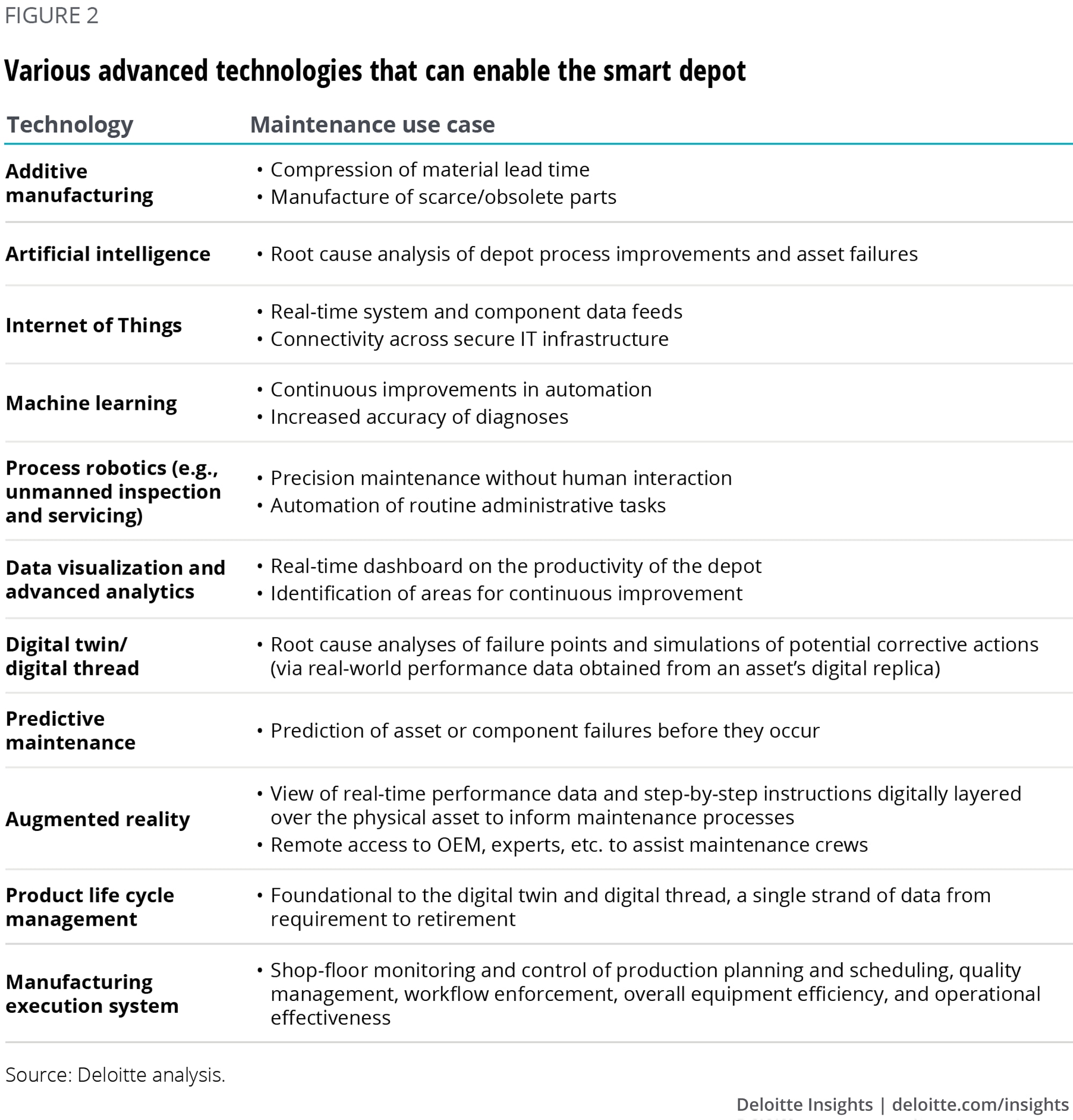
The smart depot Applying technology to increase productivity
11 minute read
21 February 2019
Imagine a smart military depot—one that anticipates weapons’ maintenance needs and provides visibility into the entire sustainment ecosystem. How can military services create—and use—such a facility?
A military aircraft arrives at a Department of Defense (DoD) facility for routine maintenance. Artisans surround the fuselage, scan it to assess its condition, and induct the asset. Its data is transmitted to a product life cycle management system and overlaid on the digital twin of the aircraft to develop a detailed visual record of the equipment and define specific repair requirements.1 Electronic work orders are created to guide the maintenance activities.
Learn more
Download the PDF
Explore the Industry 4.0 collection
Visit the Aerospace & defense collection
Depot personnel have determined that certain parts are not available, which causes specialists in reverse engineering, metrology, program management, testing and engineering, and materiel to work together to develop and additively manufacture replacement parts, making the aircraft mission-capable. Further, should the digital twin for this particular aircraft yield analysis that suggests other components may be nearing a breakdown, they can be predictively repaired before they malfunction. Availability and mission capability metrics for the aircraft are recorded using a system that is standardized across the command, providing a complete view of the overall state, costs, and drivers of readiness.
The command maintains a complete record of this aircraft tail number throughout its life cycle. This record, captured in a digital thread,2 encompasses a comprehensive body of knowledge about the aircraft as designed, manufactured, and maintained. This body of knowledge travels with the aircraft to any facility, anywhere in the world, and gets updated with each new event.
Imagine a smart depot—one that anticipates when weapons systems, subsystems, and components require maintenance; provides visibility into the entire maintenance and sustainment ecosystem; produces critical components on demand; and improves tracking of on-field part performance. This smart depot leverages sensors, advanced connected technologies, and autonomous systems to dramatically improve readiness and optimize supportability.
In this article, we examine the smart depot and its imperative in the age of advanced, connected technologies—specifically:
- The definition of a smart depot and its core components
- The foundational elements required for a smart depot
- Key technology and organizational considerations necessary for a smart depot
Defining the smart depot for 2030
A smart depot applies advanced digital and physical technologies to increase repair productivity at DoD facilities. This is enabled by an ecosystem of various stakeholders—maintenance crews at the depots, intermediate and operational (I- and O-level) maintenance crews, product support managers, item managers, original equipment and component manufacturers, and, ultimately, the warfighter—all connected through a digital supply network (DSN).3 This system, in turn, helps improve the visibility of incoming and outgoing systems and materiel availability, reliability, and scheduling; it also reduces maintenance cycles, ownership costs, and repair turnaround time, contributing to significant gains across DoD enterprises.4
Foundational to this integrated vision is a single, authoritative data set that can enable a host of new capabilities for the smart depot.5 Incoming data on the current state of systems, inventory of spare parts, efficiency of a maintenance process, and other metrics help smart depots address sustainment more effectively—all while ensuring original equipment manufacturers (OEMs), repair part manufacturers, maintenance crews at the depot, and I- and O-level maintainers are drawing insights from the same, standardized set of information.
For more information about the digital supply network, see The rise of the digital supply network.
Why depots need to be smarter
In FY2016, depot-level maintenance operations supported 440,000 ground combat and tactical vehicles, 14,000 aircraft or helicopters, 780 strategic missiles, and 225 ships. This depot-level maintenance cost US$32 billion, with over US$17 billion of this work being done internally at DoD depots.6 Materiel readiness is one of the primary outcomes for the maintenance community, and increased depot productivity can lead to improved materiel readiness.
Currently, depot performance faces challenges in reducing maintenance backlogs. This is complicated by the fact that depot workload is labor-intensive and may not yet have broad, ready access to technology to collect and use real-time data that might augment the complex maintenance processes, enable predictive capabilities, and better inform decision-making.7 The manual collection and transfer of information can lead to inefficiencies within the depot and between maintenance ecosystem players, including OEMs, repair part manufacturers, maintenance crews at the depot, I- and O-level maintainers, and the warfighter.
To better understand how enhanced depot productivity—and, ultimately, the smart depot—can contribute to reaching materiel readiness goals, DoD leaders can look to the commercial sector for examples of applications related to manufacturing, warehouse operations, and inventory and quality management, among others.8 Overall, 62 percent of executives in the commercial sector are prioritizing digital transformation investments in their supply chains, while 35 percent are doing so in smart facilities specifically.9
For example, the automotive sector is aggressively setting up smart factories. The sector is making larger investments and setting higher targets for its digital manufacturing operations than any other sector. By the end of 2022, automotive manufacturers expect that 24 percent of their plants will be smart factories, and 49 percent of automakers have already invested more than 250 million dollars in smart factories.10
Many commercial organizations utilize connected technologies and the resulting surge of data to optimize maintenance processes, drive maintenance visibility, and make more predictive, agile decisions.11 Similar principles can be applied in the DoD to create the smart depot. We’ll explore how in the next section.
Conditions for the smart depot’s success
Figure 1 illustrates how a fully realized smart depot can improve the maintenance life cycle and associated visibility for critical systems.

The conditions needed to fully realize the smart depot are expected to include a well-structured governance model, a technologically capable workforce, a connected IT infrastructure, and an easily accessible, single authoritative set of data upon which to base planning and analysis.
A well-structured governance model
A transformation to the smart depot could dramatically alter traditional processes, organizational structures, and decision rights. Therefore, a governance model should guide or accelerate the adoption of smart depot solutions. The governance model should consider three factors: leadership, engagement, and scale.
All transformation efforts typically require strong leadership. Building the smart depot can potentially cause such disruption that the effort should be owned (not just sponsored) by the most senior executive in the maintenance chain of command. This means that the executive participates regularly in team meetings, makes personnel decisions, understands the schedule, and sets the vision. The leading executive should be involved in setting clear goals supported by clear metrics. These goals should be tied to business results or outputs (for example, how many additional aircraft are repaired per month).
Further, given the broad and transformative nature of the smart depot, the organization as a whole should be engaged in the shift, rather than a special projects team allotting only part-time effort. Depot personnel who are staffed to the effort should have strong technical acumen, along with clearly defined roles and decision rights. At the same time, these personnel should also remain tied to their “everyday” job to ensure the depot keeps running. In fact, depots can engage in transformation while continuing to work through their annual workload; given their mission, they generally don’t have the freedom to shut down for long periods of time to reorient their processes. This would constitute extra effort, to be sure, combined with a sharp incentive to get it right quickly.
Separately, the governance model should enable the development of digital leaders, particularly given the level of connectivity and the high level of deployment of digital and physical technologies. These personnel should be nurtured and assigned roles that can accelerate the transformation, including training the next generation of digital leaders. Much of this transformation could potentially be done via both formal and informal chains of command, as not all will find it easy to accept these transformations and change their mindsets.
Finally, the transformation should be scalable. All too often, organizations undertake digital projects as one-off efforts, disconnected from each other and from a broader overarching strategy. Leaders should understand what scaling looks like within the context of each program and set clear targets and schedules to get there. This typically requires addressing legacy roles and tools (for example, leveraging the enterprise resource planning platform during the transformation), as well as understanding when to implement newer systems and processes. The opportunity is great; therefore, significant attention should be allotted to the effort.
A technologically capable, collaborative workforce
Transforming the depot to leverage digital advances typically requires not just technological skills but human ones as well. Half of the commercial manufacturers adopting digital and automation technologies note that skills such as technology/computer facility, digital expertise, programming capabilities, and critical thinking are essential to smart manufacturing.12 What’s important to note here, however, is that human skills—such as critical thinking—were ranked as a top driver of competitiveness by global manufacturing executives.13 While it was noted in the context of commercial leaders, this finding seems relevant to the smart depot as well, as the ability to adapt to unexpected challenges and find innovative ways to solve complex problems can be critical in this setting.
Creating a technologically advanced workplace can also allow depots to become an attractive option for new generations of talent. Strategic approaches are often necessary to attract and retain the necessary workforce, including in-house training focused on new and emerging technologies, and the engagement of a multigenerational workforce. The DoD is exploring several types of hiring and training practices to attract many diverse types of workers and create an environment conducive to a smart depot,14 including internal training programs such as the US Navy’s plan for additive manufacturing training in fiscal years 2017 and 2018.15 Beyond this, the challenge of the aging workforce inherent in the manufacturing sector should also be considered when planning recruiting, hiring, training, and retention strategies.16
Breaking down functional silos and increasing collaboration are also part of enabling the smart depot. Aligning resources in this way can not only drive down process days and labor but also can lead to innovative solutions and cross-pollination of expertise and skills. For example, within the US Air Force, depots can bring together experts in reverse engineering, metrology, testing, engineering, and materiel in Rapid Reaction cells to develop replacement parts as required when inventory is not available, thereby improving equipment and materiel availability and creating new approaches that can be applied to future needs.
Connected IT infrastructure
Within the IT realm, a foundational element of the smart depot is the interconnectivity of all systems and processes within the ecosystem. To implement interconnectivity and manage the resulting data flows, upgrades to operational and information technology (OT and IT) are required—as is cybersecurity to protect all classes of information that would travel across the multitude of connected devices.17
OT hardware and software can detect or drive changes in physical processes through direct monitoring and control of physical devices such as valves and pumps. IT, on the other hand, focuses on hardware and software that store, retrieve, transmit, and manipulate data. Unifying IT and OT capabilities and processes can enable smart depots to monitor, address, and predict digital and physical events.
Linking IT and OT capabilities sets the stage for the deployment of DSN enablers, such as the digital twin. With a digital twin, for example, the asset need not be physically present before depot-level maintenance activities can begin. In an interconnected environment, the depot can access actual field performance data, conduct analysis and simulations, and determine corrective actions during transit of the physical asset to the depot, so maintenance crews have a determined course of action and are ready to go before the materiel has even arrived. In this way, operational maintenance lead times can decrease, improving overall readiness.
But the digital twin is not the only tool depots can consider. Figure 2 describes a core set of enabling technologies that can be used to build capabilities in the smart depot, along with sample use cases describing maintenance productivity enhancements.

Easily accessible, single authoritative set of data
For it to be successful, the smart depot should be built on real-time insight into materiel conditions both within and outside the four walls of the facility. Once the smart depot ecosystem has end-to-end connectivity, information can be aggregated throughout the industrial base, enabling a single, centralized, and authoritative set of data that provides visibility into all systems and processes.18 A centralized data set coupled with an interconnected IT infrastructure can enable a whole host of new capabilities: more automated workflow, more precision maintenance, and a more precise work process across a connected network.
An example of the importance of this single source of data is demonstrated by the US Navy’s efforts to decrease the total cost of ownership of its platforms and weapons systems, where 70–80 percent of this cost is attributed to early design decisions that affect operations and support costs.19 This initiative has been challenged by “the absence of a centrally sponsored MBPS (model-based product support) with a commonly defined and enforced system and data architecture.”20 Without this single source of data, the required analysis cannot be completed to address the problem, and other product support services such as provisioning, support equipment, and technical publications, cannot leverage the data set for their specific needs.
Each of these conditions is a prerequisite for the development of a smart depot. The result of achieving these four conditions for success is a smart facility—and maintenance network—that is connected, optimized, agile, transparent, and proactive.21
For more information about the smart facility, see The smart factory: Responsive, adaptive, connected manufacturing.
The journey to the smart depot: Think big, start small, scale fast
As technologies continue to evolve, the development of a smart depot can seem far off in the future. However, with a clear view of the DoD’s needs, alignment with mission priorities, and a business case for adopting advanced manufacturing and maintenance technologies, depot transformations can start small and successes can be scaled to drive value. Here are some considerations to get started.
Establish overarching goals to improve readiness
Prior to defining potential solutions, organizations should start with a well-articulated vision and a thorough understanding of the issues impacting materiel readiness. For a DoD organization, this analysis can help prepare the organization for the upcoming cultural shift. From supply issues to outdated processes, a “smart depot diagnostic” can be performed to evaluate each part of the maintenance ecosystem and identify opportunities for improvement. Once the opportunities have been identified, a strategic road map and business case can be developed to establish a path for improved supply availability to minimize downtime, implementing advanced manufacturing and maintenance technologies, and prioritizing solutions based on effort and impact. The organization’s vision should reference specific performance targets and standardized metrics that track readiness to measure progress toward goals.
Key takeaways
Think broadly to identify the biggest issues impeding materiel readiness.
Develop a plan that aligns with short- and long-term goals to address these issues with improved processes and enabling technologies.
Develop pilots that incorporate advanced maintenance techniques and tools
In a Deloitte study, 56 percent of business leaders surveyed stated that they expected significant benefit from implementing a DSN; however, only 28 percent of respondents were currently implementing digital transformation initiatives.22 This apparent disparity is likely due to the perceived barriers to implementing digital solutions. To get started, depots can embrace small-scale pilots to develop and deploy enabling technologies, rather than waiting for large-scale IT transformations or complex implementation strategies to be mandated. Once success has been achieved, teams can make the case for larger investments.
Key takeaways
Within a broad perspective, choose a small test case, (e.g., a single maintenance process) to demonstrate the proof of concept and realize results.
Leverage agile methodologies to design and implement test cases to achieve quick wins and make the business case for broader investment.
Scale pilots, while managing change
Following the success of initial pilots, organizations can shift focus toward scaling smart depot capabilities across the facility. To successfully scale digital solutions, organizations should focus on their IT infrastructure, talent, governance, change management, and capital investments.
As digital technologies along with the required OT and IT infrastructure are developed and deployed across depots, clear leadership, processes, and policies should be established to coordinate various digital initiatives, such as simplifying the process of swapping and incorporating multivendor equipment and software.23 Lessons learned from pilots can be captured and leveraged for successive iterations of similar or new capabilities.
Finally, as organizations scale smart depot solutions, a cultural shift could be critical to train and retain the right talent.
Key takeaways
Incorporate lessons learned and scale successful pilots across entire maintenance lines, depots, and supply networks.
Develop the right talent to drive the transformation of supply chain delivery through training, collaboration, and change management.
Moving to a smarter, more secure future
The smart depot is connected, optimized, transparent, proactive, and agile. In order to take advantage of that smart depot, new equipment that is developed should also be “smart-compatible.” The DoD can take advantage of new capabilities enabled by advanced technologies to drive the next generation of depot modernization. The creation of and access to a robust, centralized data set improves end-to-end visibility of assets; ensures the right people and processes are in place when needed; allows maintenance teams to navigate many challenges faced by more traditional depots; standardizes viewpoints of different ecosystem participants; and improves planning capabilities, productivity, materiel availability, measurement, and responsiveness to the warfighter’s changing needs. Adopting a smart depot concept supports the DoD’s Depot Maintenance Strategy and its strategic elements to ensure that DoD’s organic depot maintenance infrastructure is prepared to meet readiness challenges and is fully integrated into the warfighter-focused sustainment enterprise of the future.24
© 2021. See Terms of Use for more information.
Explore Industry 4.0
-
3D opportunity for the Department of Defense Article10 years ago
-
Industry 4.0: At the intersection of readiness and responsibility Article5 years ago
-
Embracing a digital future Article7 years ago
-
Following the digital thread Video series7 years ago
-
Synchronizing the digital supply network Article6 years ago
-
Forget fail fast Article6 years ago
















